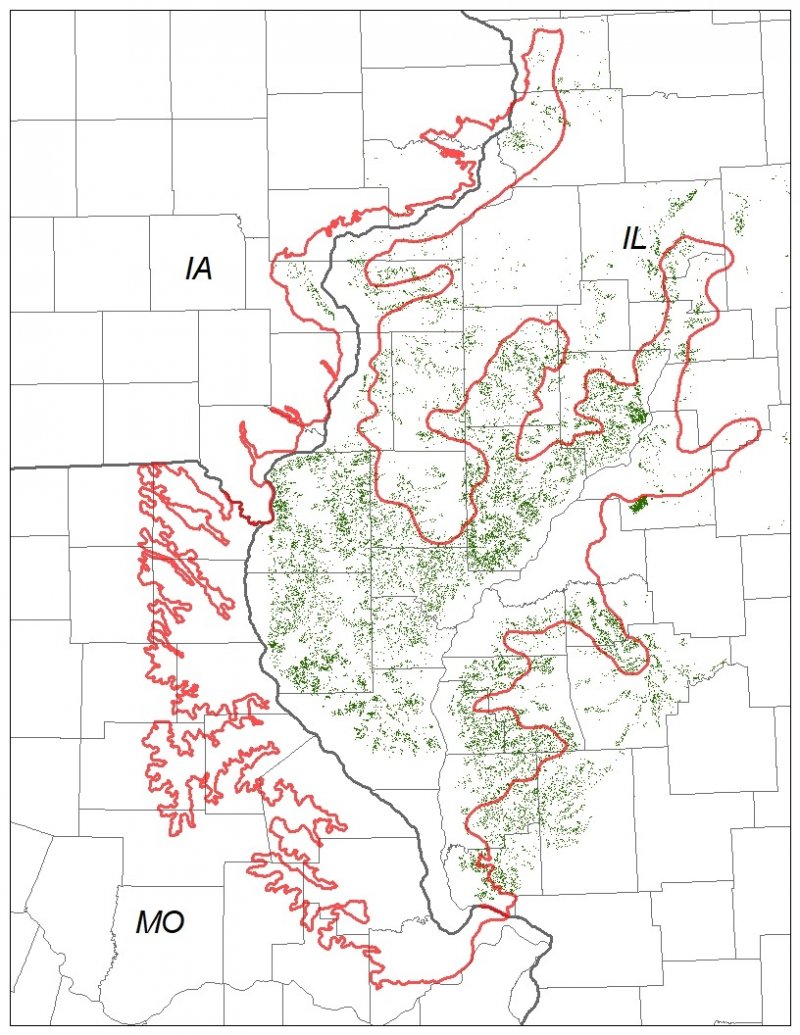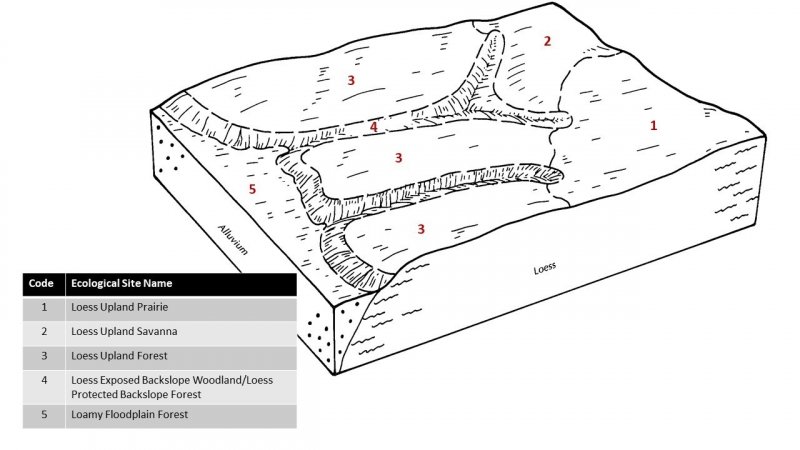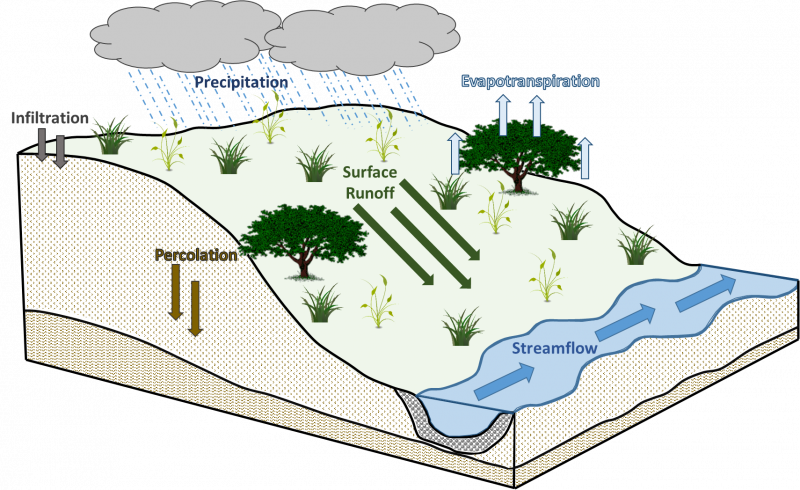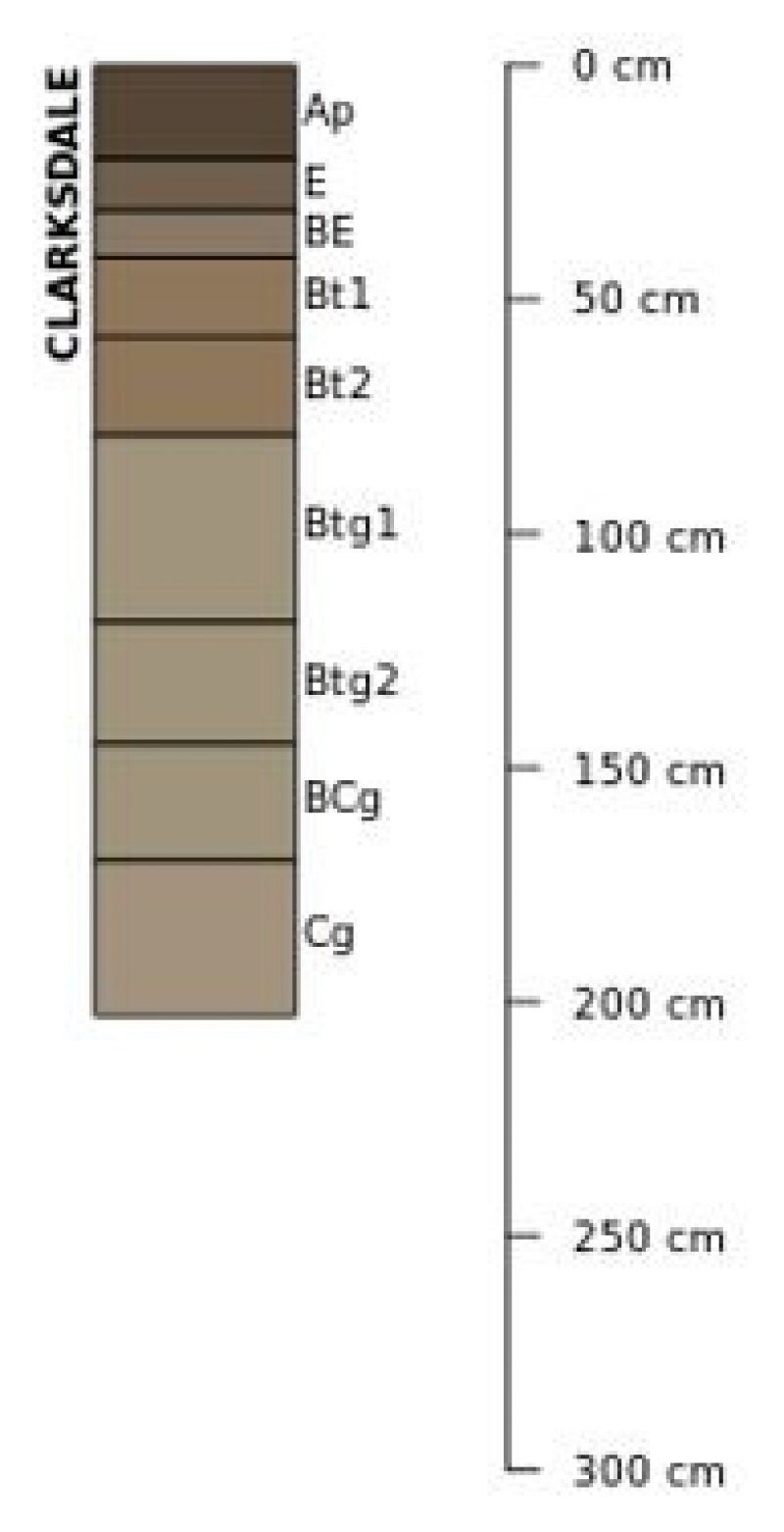Ecological dynamics
The MLRA lies within the tallgrass prairie ecosystem of the Midwest, but a variety of environmental and edaphic factors resulted in a landscape that historically supported upland hardwood forests, lowland mixed forests, and scattered grass and sedge meadows. Loess Upland Savannas form an aspect of this vegetative continuum. This ecological site occurs on uplands on somewhat poorly to well drained soils. Species characteristic of this ecological site consist of tallgrass herbaceous vegetation with scattered trees.
Fire is a critical disturbance factor that maintains Loess Upland Savannas. Fire intensity typically consisted of periodic fires occurring every 1 to 5 years (LANDFIRE 2009). Ignition sources included summertime lightning strikes from convective storms and bimodal, human ignitions during the spring and fall seasons. Native Americans regularly set fires to improve sight lines for hunting, driving large game, improving grazing and browsing habitat, agricultural clearing, and enhancing vital ethnobotanical plants (Barrett 1980; White 1994).
Drought and herbivory by native ungulates have also played a role in shaping this ecological site. The periodic episodes of reduced soil moisture in conjunction with the moderately well to well-drained soils have favored the proliferation of plant species tolerant of such conditions. Drought can also slow the growth of plants and result in dieback of certain species. Bison (Bos bison) grazing, while present, served a more limited role in community composition and structure than lands further west. Prairie elk (Cervus elaphus) and white-tailed deer (Odocoileus virginianus) likely contributed to woody species reduction but are also considered to be of a lesser impact compared to the west (LANDFIRE 2009). When coupled with fire, periods of drought and herbivory can further delay the establishment of woody vegetation (Pyne et al. 1996).
Today, Loess Upland Savannas have been greatly reduced as a result of human-driven type-conversion to agricultural production land (NatureServe 2018). Lands that have not been put into production have had fire suppressed long enough to transition the site from an open savanna to a closed woodland or forest. A return to the historic plant community may not be possible following extensive land modification, but long-term conservation agriculture or savanna reconstruction can help to restore some biotic diversity and ecological function. The state-and-transition model that follows provides a detailed description of each state, community phase, pathway, and transition. This model is based on available experimental research, field observations, literature reviews, professional consensus, and interpretations.
State 1
Reference State
The reference plant community is categorized as a mesic oak savanna, dominated by herbaceous vegetation and scattered trees. The two community phases within the reference state are dependent on periodic fires. Surface fires are the dominant fire regime, comprising approximately 96 percent of all fires and occurring every five years. Mixed and high intensity fires comprise the remaining 4 percent, occurring approximately every 3 and 1 years, respectively (LANDFIRE 2009). Fire intensity and return intervals alter species composition, cover, and extent, while regular fire intervals keep woody species from encroaching. Episodic droughts and storm damage have more localized impacts in the reference phases, but do contribute to overall species composition, diversity, cover, and productivity.
Community 1.1
Bur Oak/Big Bluestem – Longbract Wild Indigo
Sites in this reference community phase are dominated by a mix of grasses and forbs with scattered trees. Bur oak is the dominant tree on the site, but white oak (Quercus alba L.) may also be present. The tree layer comprises no more than 20 percent cover and trees size class is medium (9 to 21-inch DBH). Vegetative cover is continuous (up to 100 percent) and plants can reach heights up to 3 feet tall (LANDFIRE 2009). Big bluestem, little bluestem, Indiangrass, and prairie dropseed are the dominant warm-season grasses present on the site. Characteristic forbs can include longbract wild indigo, pride of Ohio (Dodecatheon meadia L.), prairie blazing star (Liatris pycnostachya Michx)., hoary puccoon (Lithospermum canescens (Michx.) Lehm.), and compassplant (Silphium laciniatum L.) (White and Madany 1978). Surface fires every 5 years will maintain this class, but an extended fire return interval will shift the community to phase 1.2 (LANDFIRE 2009).
Community 1.2
Bur Oak/Prairie Willow – Leadplant/Big Bluestem
This reference community phase represents a successional shift as a result of an extended fire return interval. This fire-free period allows woody shrubs to establish, including prairie willow (Salix humilis Marshall) and leadplant (Amorpha canescens Pursh). Tree cover increases to as much as 60 percent, and tree size class moves from medium to large (21 to 33-inch DBH). Surface fires every 5 years will maintain this class, but mixed or high intensity fires will shift the community back to phase 1.1 (LANDFIRE 2009).
Pathway 1.1A
Community 1.1 to 1.2
Extended fire return interval in excess of 5 years.
Pathway 1.2A
Community 1.2 to 1.1
Mixed or high intensity fire.
State 2
Fire Suppressed State
Fire suppression can transition the reference plant community from an open savanna to a closed canopy forest. As the natural fire regime is removed from the landscape, encroachment and dominance by shade-tolerant, fire-intolerant species ensues (Asbjornsen et al. 2005). This results in a positive feedback loop of mesophication whereby plant community succession continuously creates cool, damp shaded conditions that perpetuate a closed canopy ecosystem (Nowacki and Abrams 2008). Succession to this closed canopy state can occur in as little as 25 years from the last fire (LANDFIRE 2009).
Community 2.1
Bur Oak – White Oak/Bitternut Hickory/Pennsylvania Sedge
This community represents the early stages of long-term fire suppression. The lack of fire allows the tree canopy to close (60 to 80 percent cover) and stem density to increase. Bur oak and white oak are the dominant trees, and bitternut hickory (Carya cordiformis (Wangenh.) K. Koch) begins to form a scattered subcanopy (LANDFIRE 2009). The sun-loving herbaceous layer is slowly replaced by more shade-tolerant species. Rare surface fires that escape suppression efforts will maintain this phase, but a complete lack of fire for 30 years will shift the community to phase 2.2 (LANDFIRE 2009).
Community 2.2
White Oak – Bitternut Hickory/Pennsylvania Sedge
Sites falling into this community phase have transitioned into a closed canopy oak-hickory forest. Mature bur and white oaks are still present, but seedings and saplings are generally absent as they do not establish well under the continuous canopies (Tirmenstein 1991; Gucker 2011). As fire suppression has continued, bitternut hickory saplings have matured and now become co-dominant with the oaks (Colandonato 1992; LANDFIRE 2009). The ground layer continues to be dominated by shade-tolerant species or non-native invasive species, such as garlic mustard (Alliaria petiolata (M. Bieb.) Cavara & Grande). A single, large disturbance event – such as a windstorm – can create open pockets that allow the community to temporarily shift back to phase 2.1.
Pathway 2.1A
Community 2.1 to 2.2
Continued fire suppression (+30 years)
Pathway 2.2A
Community 2.2 to 2.1
A large disturbance event, such as a fire.
State 3
Pasture State
The pasture state occurs when the reference state is converted to a farming system that emphasizes domestic livestock production known as grassland agriculture. Fire suppression, periodic cultural treatments (e.g., clipping, drainage, soil amendment applications, planting new species and/or cultivars, mechanical harvesting) and grazing by domesticated livestock transition and maintain this state (USDA-NRCS 2003). Early settlers seeded non-native species, such as smooth brome (Bromus inermis Leyss.), tall fescue ( Festuca arundinacea) and Kentucky bluegrass (Poa pratensis L.), to help extend the grazing season. Over time, as lands were continuously harvested or grazed by herds of cattle, the non-native species were able to spread and expand across the landscape, reducing the native species diversity and ecological function.
Community 3.1
Hayfield
Sites in this community phase consist of forage plants that are planted and mechanically harvested. Mechanical harvesting removes much of the aboveground biomass and nutrients that feed the soil microorganisms (Franzluebbers et al. 2000; USDA-NRCS 2003). As a result, soil biology is reduced leading to decreases in nutrient uptake by plants, soil organic matter, and soil aggregation. Frequent biomass removal can also reduce the site’s carbon sequestration capacity (Skinner 2008). Many species may be planted depending on the landowner's objectives.
Community 3.2
Smooth brome -Tall fescue - Clover Pasture
This community is characterized by seeded cool-season grass and forbs. Species will depend upon landowner goals and objectives and may include many different grasses and forbs. Common species include smooth brome (Bromus inermis), tall fescue (Festuca arundinacea), Kentucky bluegrass (Poa pratensis), timothy (Phleum pratense), red clover ( Trifolium pratense) and white clover (Trifolium repens L.). Management inputs include control of weeds and brush. These sites are managed to ensure a proper forage/animal balance. Plants are not overutilized and have adequate rest and recovery.
Community 3.3
Broomsedge -Thistle-Smooth brome -Tall fescue Pasture
Overutilization of the pasture will result in a shift to include more undesirable species such as thistle (Cirsium spp.), broomsedge (Andropogon virginicus L.), ironweed (Vernonia gigantea), buttercup (Ranunculus spp.), ragweed (Ambrosia spp.) and blackberries (Rubus spp.). Many woody and weed species may be present depending on seed sources and level of soil disturbance. This community reflects an improper forage-to-animal balance which will negatively impact forage productivity and reproduction, soil health, and water quality. Ecological resiliency is compromised under these conditions.
Pathway 3.1A
Community 3.1 to 3.2
Mechanical harvesting is replaced with domestic livestock grazing.
Pathway 3.1B
Community 3.1 to 3.3
Mechanical harvesting is replaced with domestic livestock grazing. Forage plants are overutilized.
Pathway 3.2A
Community 3.2 to 3.1
Domestic livestock are removed, and mechanical harvesting is implemented.
Pathway 3.2B
Community 3.2 to 3.3
Grazing of livestock with overutilization of the forage plants.
Pathway 3.3B
Community 3.3 to 3.1
Domestic livestock are removed, and mechanical harvesting is implemented.
Pathway 3.3A
Community 3.3 to 3.2
Forage plants are not overutilized and the site has a proper forage-to-animal balance.
State 4
Cropland State
The continuous use of tillage, row-crop planting, and chemicals (i.e., herbicides, fertilizers, etc.) has effectively eliminated the reference community and many of its natural ecological functions in favor of crop production. Corn and soybeans are the dominant crops for the site, and oats (Avena L.) and alfalfa (Medicago sativa L.) may be rotated periodically. These areas are likely to remain in crop production for the foreseeable future.
Dominant plant species
-
soybean (Glycine max), other herbaceous
-
corn (Zea mays), other herbaceous
Community 4.1
Conventional Tillage Field
Sites in this community phase typically consist of monoculture row-cropping maintained by conventional tillage practices. They are cropped in either continuous corn or corn-soybean rotations. The frequent use of deep tillage, low crop diversity, and bare soil conditions during the non-growing season negatively impacts soil health. Under these practices, soil aggregation is reduced or destroyed, soil organic matter is reduced, erosion and runoff are increased, and infiltration is decreased, which can ultimately lead to undesirable changes in the hydrology of the watershed (Tomer et al. 2005).
Dominant plant species
-
corn (Zea mays), other herbaceous
-
soybean (Glycine max), other herbaceous
Community 4.2
Conservation Tillage Field
This community phase is characterized by rotational crop production that utilizes various conservation tillage methods to promote soil health and reduce erosion. Conservation tillage methods include strip-till, ridge-till, vertical-till, or no-till planting systems. Strip-till keeps seedbed preparation to narrow bands less than one-third the width of the row where crop residue and soil consolidation are left undisturbed in-between seedbed areas. Strip-till planting may be completed in the fall and nutrient application either occurs simultaneously or at the time of planting. Ridge-till uses specialized equipment to create ridges in the seedbed and vegetative residue is left on the surface in between the ridges. Weeds are controlled with herbicides and/or cultivation, seedbed ridges are rebuilt during cultivation, and soils are left undisturbed from harvest to planting. Vertical-till systems employ machinery that lightly tills the soil and cuts up crop residue, mixing some of the residue into the top few inches of the soil while leaving a large portion on the surface. No-till management is the most conservative, disturbing soils only at the time of planting and fertilizer application. Compared to conventional tillage systems, conservation tillage methods can improve soil ecosystem function by reducing soil erosion, increasing organic matter and water availability, improving water quality, and reducing soil compaction.
Dominant plant species
-
corn (Zea mays), other herbaceous
-
soybean (Glycine max), other herbaceous
Community 4.3
Conservation Tillage Field/ Cover Crop Field
This community phase applies conservation tillage methods as described above as well as adds cover crop practices. Cover crops typically include nitrogen-fixing species (e.g., legumes), small grains (e.g., rye, wheat, oats), or forage covers (e.g., turnips, radishes, rapeseed). The addition of cover crops not only adds plant diversity but also promotes soil health by reducing soil erosion, limiting nitrogen leaching, suppressing weeds, increasing soil organic matter, and improving the overall soil ecosystem. In the case of small grain cover crops, surface cover and water infiltration are increased, while forage covers can be used to graze livestock or support local wildlife. Of the three community phases for this state, this phase promotes the greatest soil sustainability and improves ecological functioning within a cropland system.
Pathway 4.1A
Community 4.1 to 4.2
Tillage operations are greatly reduced, crop rotation occurs on a regular interval, and crop residue remains on the soil surface.
Pathway 4.1B
Community 4.1 to 4.3
Tillage operations are greatly reduced or eliminated, crop rotation occurs on a regular interval, crop residue remains on the soil surface, and cover crops are planted following crop harvest.
Pathway 4.2A
Community 4.2 to 4.1
Intensive tillage is utilized, and monoculture row-cropping is established.
Pathway 4.2B
Community 4.2 to 4.3
Cover crops are implemented to minimize soil erosion.
Pathway 4.3B
Community 4.3 to 4.1
Intensive tillage is utilized, cover crops practices are abandoned, monoculture row-cropping is established, and crop rotation is reduced or eliminated.
Pathway 4.3A
Community 4.3 to 4.2
Cover crop practices are abandoned.
State 5
Reconstructed Tallgrass Oak Savanna State
Savanna reconstructions have become an important tool for repairing natural ecological functions and providing habitat protection for numerous grassland dependent species. Because the historic plant and soil biota communities of the tallgrass prairie were highly diverse with complex interrelationships, historic savanna replication cannot be guaranteed on landscapes that have been so extensively manipulated for extended timeframes (Kardol and Wardle 2010; Fierer et al. 2013). Therefore, ecological restoration should aim to aid the recovery of degraded, damaged, or destroyed ecosystems. A successful restoration will have the ability to structurally and functionally sustain itself, demonstrate resilience to the natural ranges of stress and disturbance, and create and maintain positive biotic and abiotic interactions (SER 2002). The reconstructed savanna state is the result of a long-term commitment involving a multi-step, adaptive management process. Bur oak plantings or selective tree thinning of non-oak species will be required to reproduce the overstory canopy (Asbjornsen et al. 2005). Diverse, species-rich seed mixes may be important to utilize as they allow the site to undergo successional stages that exhibit changing composition and dominance over time (Smith et al. 2010). On-going management via prescribed fire and/or light grazing will help the site progress from an early successional community dominated by annuals and some weeds to a later seral stage composed of native perennial grasses, forbs, shrubs, and eventually mature bur oaks. Establishing a prescribed fire regime that mimics natural disturbance patterns can increase native species cover and diversity while reducing cover of non-native forbs and grasses. Light grazing alone can help promote species richness, while grazing accompanied with fire can control the encroachment of undesirable woody vegetation (Brudvig et al. 2007).
Community 5.1
Early Successional Reconstructed Oak Savanna
This community phase represents early community assembly and is highly dependent on the timing and priority of planting and/or tree thinning operations and the herbaceous seed mix utilized. If bur oak planting is needed, acorns should be planted shortly after harvest as acorns germinate shortly after seedfall and require no cold stratification. Browse protection may need to be installed to protect newly established seedlings from animal predation (Gucker 2011). If selective tree removal is needed, canopy reduction should encompass between 16 to 45 percent of the undesirable species in a single year (Asbjornsen et al. 2005). The seed mix should look to include a diverse mix of native cool-season and warm-season annual and perennial grasses and forbs typical of the reference state. Native, cool-season annuals can help to provide litter that promotes cool, moist soil conditions to the benefit of the other species in the seed mix. The first season following site preparation and seeding will typically result in annuals and other volunteer species forming most the vegetative cover. Control of non-native species, particularly perennial species, is crucial at this point to ensure they do not establish before the native vegetation (Martin and Wilsey 2012). After the first season, native warm-season grasses should begin to become more prominent on the landscape and over time close the canopy.
Community 5.2
Late Successional Reconstructed Oak Savanna
Appropriately timed disturbance regimes (e.g., prescribed fire) applied to the early successional community phase can help increase the beta diversity, pushing the site into a late successional community phase over time. While oak savanna communities are dominated by grasses, these species can suppress forb establishment and reduce overall diversity and ecological functioning (Martin and Wilsey 2006; Williams et al. 2007). Reducing accumulated plant litter from the tall grasses allows more light and nutrients to become available for forb recruitment, allowing for greater ecosystem complexity (Wilsey 2008). Prescribed fire should be used on a cycle no less than every five years to allow the oaks to establish and mature (Gucker 2011).
Pathway 5.1A
Community 5.1 to 5.2
Selective herbicides are used to control non-native species, and prescribed fire and/or light grazing help to increase the native species diversity and control non-oak woody vegetation.
Pathway 5.2A
Community 5.2 to 5.1
Reconstruction experiences a decrease in native species diversity from drought or improper timing of management actions (e.g., reduced fire frequency, use of non-selective herbicides).
Transition T1A
State 1 to 2
Long-term fire suppression transitions the site to the fire-suppressed state (2).
Transition T1B
State 1 to 3
Cultural treatments to enhance forage quality and yield transitions the site to the pasture state (3).
Transition T1C
State 1 to 4
Tillage, seeding of agricultural crops, and non-selective herbicide transition this site to the cropland state (4).
Transition T2A
State 2 to 3
Cultural treatments to enhance forage quality and yield transitions the site to the pasture state (3).
Transition T2B
State 2 to 4
Tillage, seeding of agricultural crops, and non-selective herbicide transition this site to the cropland state (4).
Restoration pathway R2A
State 2 to 5
Site preparation, invasive species control, and seeding native species transition this site to the reconstructed tallgrass oak savanna state (5).
Transition T3A
State 3 to 2
Land abandonment and/or fire suppression transitions the site to the fire-suppressed state (2).
Constraints to recovery. Fire suppression; land abandonment
Transition T3B
State 3 to 4
Tillage, seeding of agricultural crops, and non-selective herbicide transition this site to the cropland state (4).
Restoration pathway R3A
State 3 to 5
Site preparation, invasive species control, and seeding native species transition this site to the reconstructed oak savanna state (5).
Transition T4A
State 4 to 2
Land abandonment and/or fire suppression transitions the site to the fire-suppressed state (2).
Transition T4B
State 4 to 3
Cultural treatments to enhance forage quality and yield transitions the site to the pasture state (3).
Restoration pathway R4A
State 4 to 5
Site preparation, tree planting, invasive species control, and seeding native species transition this site to the reconstructed state (5).
Transition T5A
State 5 to 2
Fire suppression and removal of active management transitions this site to the fire-suppressed state (2).
Transition T5B
State 5 to 3
Cultural treatments to enhance forage quality and yield transition the site to the pasture state (3).
Transition T5C
State 5 to 4
Tillage, seeding of agricultural crops, and non-selective herbicide transition this site to the cropland state (4).




